Abstract
Accurate electrical daily peak load forecasting (DPLF) is essential for power system management in order to prevent overloading and grid failure. Fuzzy neural networks have been successfully applied to load forecasting due to their nonlinear mapping and generalized behavior. In this paper, a neuro-fuzzy based DPLF (N-DPLF) model with a feature selection method is proposed for DPLF. The load data is clustered into seven subsets according to the season and day type. For each subset, the four features with the highest salience ranks are selected. After training N-DPLF model, the formed BSWs (bounded sum of weighted fuzzy membership functions) in accordance with the selected features denote characteristics of these features. The N-DPLF model provides explicit BSWs in hyperboxes, instead of the uncertain black box nature of neural network models, so that the selected features can be interpreted by the visually constructed BSWs. The N-DPLF model with a feature selection method shows a mean absolute percentage error (MAPE) of 1.86 % using Korea Power Exchange data over 1-year period.






Similar content being viewed by others
References
Abdel-Aal RE (2006) Modeling and forecasting electric daily peak loads using abductive networks. Electr Power Energy Syst 28:133–141
Alves da Silva AP, Ferreira VH, Velasquez RMG (2008) Input space to neural network based load forecasters. Int J Forecast 24(4):616–629
Amin-Naseri MR, Soroush AR (2008) Combined use of unsupervised and supervised learning for daily peak load forecasting. Energy Convers Manag 49:1302–1308
Amjady N (2001) Short-term hourly load forecasting using time-series modeling with peak load estimation capability. IEEE Trans Power Syst 16:798–805
Chai SH, Lim JS (2007) Economic turning point forecasting using fuzzy neural network and non-overlap area distribution measurement method. Korean Econ Rev 23(1):111–130
Chai SH, Lim JS (2007) Nonlinear time series prediction modeling by weighted average defuzzification based on NEWFM (in Korean). J Intell Inf Syst 17(4):160–165
Charytoniuk W, Chen M, Olinda P (1998) Nonparametric regression based short-term load forecasting. IEEE Trans Power Syst 13:725–730
Chen B, Chang M, Lin C (2004) Load forecasting using support vector machines: a study on eunite competition 2001. IEEE Trans Power Syst 19(4):1821–1830
Chen Y, Luh PB, Zhao Y, Michel LD, Coolbeth MA, Friedland PB, Rourke SJ (2010) Short-term load forecasting: similar day-based wavelet neural networks. IEEE Trans Power Syst 25(1):322–330
Chung KY (2013) Recent trends on convergence and ubiquitous computing. Pers Ubiquit Comput. doi:10.1007/s00779-013-0743-2
Chung KY, Na YJ, Lee JH (2013) Interactive design recommendation using sensor based smart wear and weather WebBot. Wirel Pers Commun 73(2):243–256
Drezga I, Rahman S (1998) Input variable selection for ANN-based short-term load forecasting. IEEE Trans Power Syst 13(4):1238–1244
Fan S, Chen L (2006) Short-term load forecasting based on an adaptive hybrid method. IEEE Trans Power Syst 21(1):392–401
Hanmandlu M, Chauhan BK (2011) Load forecasting using hybrid models. IEEE Trans Power Syst 26(1):20–29
Hippert HS, Taylor JW (2010) An evaluation of Bayesian techniques for controlling model complexity and selecting inputs in a neural network for short-term load forecasting. Neural Netw 23:386–395
Hippert HS, Pedreira CE, Souza RC (2001) Neural networks for short-term load forecasting: a review and evaluation. IEEE Trans Power Syst 16:44–55
Huang S-J, Shih K-R (2003) Short-term load forecasting via ARMA model identification including non-gaussian process considerations. IEEE Trans Power Syst 18(2):673–679
Huang H-C, Hwang R-C, Hsieh J-G (2002) A new artificial intelligent peak power load forecaster based on non-fixed neural networks. Electr Power Energy Syst 24(3):245–250
Jo NH, Song K-B, Roh Y, Kang D (2006) A study on the short-term load forecasting using support vector machine (in Korean). Trans KIEE 55A(7):306–312
Jung EY, Kim JH, Chung KY, Park DK (2013) Home health gateway based healthcare services through U-health platform. Wirel Pers Commun 73(2):207–218
Kim C, Yu I, Song YH (2002) Kohonen neural network and wavelet transform based approach to short-term load forecasting. Electr Power Energy Syst 63:169–176
Kim JY, Chung KY, Jung JJ (2014) Single tag sharing scheme for multiple-object RFID applications. Multimedia Tools Appl 68(2):465–477
Ko JW, Chung KY, Han JS (2013) Model transformation verification using similarity and graph comparison algorithm. Multimedia Tools Appl. doi:10.1007/s11042-013-1581-y
Lauret P, Fock E, Randrianarivony RN, Manicom-Ramsamy J-F (2008) Bayesian neural network approach to short time load forecasting. Energy Convers Manag 49:1156–1166
Lee S-H, Lim JS (2011) Forecasting KOSPI based on a neural network with weighted fuzzy membership functions. Expert Syst Appl 38:4259–4263
Liao G-C, Tsao T-P (2006) Application of a fuzzy neural network combined with a chaos genetic algorithm and simulated annealing to short term load forecasting. IEEE Trans Evol Comput 10(3):330–340
Lim JS (2009) Finding features for real-time premature ventricular contraction detection using a fuzzy neural network system. IEEE Trans Neural Netw 20(3):522–527
Lim JS, Wang D, Kim Y-S, Gupta S (2006) A neuro-fuzzy approach for diagnosis of antibody deficiency syndrome. Neurocomputing 69(7–9):969–974
Mao H, Zeng X-J, Leng G, Zhai Y-J, Keane JA (2009) Short-term and midterm load forecasting using a bilevel optimization model. IEEE Trans Power Syst 24(2):1080–1090
Pandian SC, Duraiswamy K, Rajan CCA, Kanagaraj N (2006) Fuzzy approach for short term load forecasting. Electr Power Syst Res 76:541–548
Reis AJR, da Silva APA (2005) Feature extraction via multiresolution analysis for short-term load forecasting. IEEE Trans Power Syst 20(1):189–198
Rho MJ, Jang KS, Chung KY, Choi IY (2013) Comparison of knowledge, attitudes, and trust for the use of personal health information in clinical research. Multimedia Tools Appl. doi:10.1007/s11042-013-1772-6
Saini LM, Soni MK (2002) Artificial neural network-based peak load forecasting using conjugate gradient methods. IEEE Trans Power Syst 17(3):907–912
Senjyu T, Mandal P, Uezato K, Funabashi T (2005) Next day load curve forecasting using hybrid correction method. IEEE Trans Power Syst 20(1):102–109
Sheikhan N, Mohammadi N (2011) Neural-based electricity load forecasting using hybrid of GA and ACO for feature selection. Neural Comput & Applic. doi:10.1007/s00521-011-0599-1
Siwek K, Osowski S, Szupiluk R (2009) Ensemble neural network approach for accurate load forecasting in a power system. Int J Appl Math Comput Sci 19(2):303–315
Song GY, Cheon Y, Lee K, Lim H, Chung KY, Rim HC (2013) Multiple categorizations of products: cognitive modeling of customers through social media data mining. Pers Ubiquit Comput. doi:10.1007/s00779-013-0740-5
Subbaraj P, Rajasekaran V (2008) Evolutionary techniques based combined artificial neural networks for peak load forecasting. World Acad Sci Eng Technol 45:680–686
Takagi T, Sugeno M (1985) Fuzzy identification of systems and its applications to modeling and control. IEEE Trans Syst Man Cybern 15:116–132
Taylor JW, Buizza R (2002) Neural network load forecasting with weather ensemble predictions. IEEE Trans Power Syst 17(3):626–632
Taylor J, McSharry P (2007) Short-term load forecasting methods: an evaluation based on european data. IEEE Trans Power Syst 22(4):2213–2219
Xiao Z, Ye S-J, Zhang B, Sun C-X (2009) BP neural network with rough set for short term load forecasting. Expert Syst Appl 36:273–279
Yun Z, Quan Z, Caixin S, Shaolan L, Yuming L, Yang S (2008) RBF neural network and ANFIS-based short-term load forecasting approach in real-time price environment. IEEE Trans Power Syst 23(3):853–858
Acknowledgments
This work was supported by the Power Generation & Electricity DeliveryCore Technology Program of the Korea Institute of Energy Technology Evaluation and Planning (KETEP), granted financial resource from the Ministry of Trade, Industry & Energy, Republic of Korea. (No. 2013T100200068).
Author information
Authors and Affiliations
Corresponding author
Rights and permissions
About this article
Cite this article
Son, SY., Lee, SH., Chung, K. et al. Feature selection for daily peak load forecasting using a neuro-fuzzy system. Multimed Tools Appl 74, 2321–2336 (2015). https://doi.org/10.1007/s11042-014-1943-0
Published:
Issue Date:
DOI: https://doi.org/10.1007/s11042-014-1943-0




